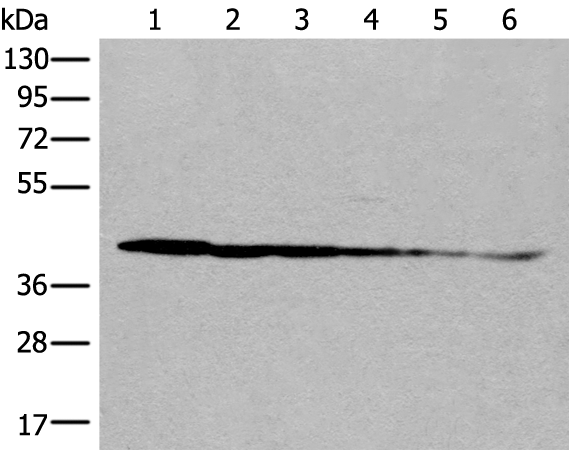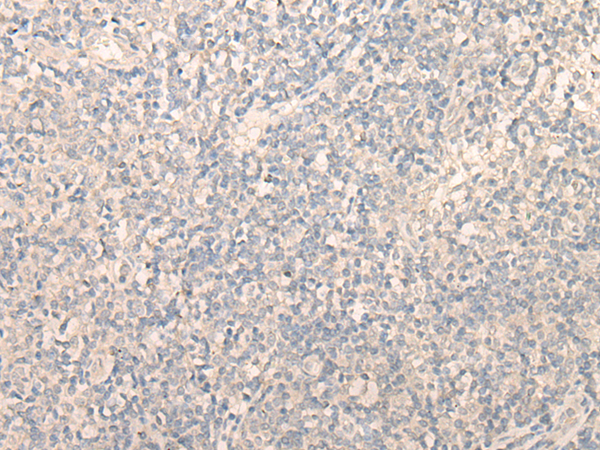

| WB | 咨询技术 | Human,Mouse,Rat |
| IF | 咨询技术 | Human,Mouse,Rat |
| IHC | 1/30-1/150 | Human,Mouse,Rat |
| ICC | 技术咨询 | Human,Mouse,Rat |
| FCM | 咨询技术 | Human,Mouse,Rat |
| Elisa | 1/5000-1/10000 | Human,Mouse,Rat |
| Aliases | VIB1B; PtdInsTP; PI-TP-beta |
| WB Predicted band size | 32 kDa |
| Host/Isotype | Rabbit IgG |
| Antibody Type | Primary antibody |
| Storage | Store at 4°C short term. Aliquot and store at -20°C long term. Avoid freeze/thaw cycles. |
| Species Reactivity | Human, Mouse, Rat |
| Immunogen | Fusion protein of human PITPNB |
| Formulation | Purified antibody in PBS with 0.05% sodium azide and 50% glycerol. |
+ +
以下是3篇与PITPNB抗体相关的文献示例(注:部分内容基于文献主题概括,建议通过学术数据库核实原文):
---
1. **文献名称**: *PITPNB controls retinal degeneration through regulating lysosome-phagosome maturation in Drosophila*
**作者**: Wang T. et al.
**摘要**: 本研究利用PITPNB特异性抗体,揭示了该蛋白在果蝇视网膜细胞中通过调控溶酶体-吞噬体成熟途径维持光感受器稳态的作用,抗体用于Western blot和免疫荧光定位分析。
2. **文献名称**: *Phosphatidylinositol transfer protein β (PITPNB) is essential for cytokinesis and spermatogenesis in mice*
**作者**: Xie H. et al.
**摘要**: 通过构建PITPNB基因敲除小鼠模型,结合抗体检测蛋白表达,发现PITPNB缺失导致细胞分裂异常和雄性不育,提示其在胞质分裂中具有关键功能。
3. **文献名称**: *PITPNB interacts with ARF GTPases to promote vesicle formation in glioma cells*
**作者**: Lee S. et al.
**摘要**: 研究利用免疫共沉淀(Co-IP)和PITPNB抗体,证明其与ARF1/ARF6的相互作用促进胶质瘤细胞囊泡运输,可能影响肿瘤侵袭性。
---
如需具体文献,建议通过PubMed或Google Scholar以关键词“PITPNB antibody”、“PITPNB function”检索近年研究。
The PITPNB (Phosphatidylinositol Transfer Protein Beta) antibody is a crucial tool for studying the function and regulation of the PITPNB protein, which plays a pivotal role in intracellular lipid transport and signaling. PITPNB belongs to the phosphatidylinositol transfer protein (PITP) family, facilitating the transfer of phosphatidylinositol (PI) and phosphatidylcholine (PC) between membrane compartments. This activity is essential for maintaining lipid homeostasis, membrane trafficking, and signal transduction pathways, particularly those involving phosphoinositides. Dysregulation of PITPNB has been implicated in various physiological and pathological processes, including neurodevelopment, cancer progression, and metabolic disorders.
Researchers utilize PITPNB antibodies primarily in techniques like Western blotting, immunofluorescence, and immunohistochemistry to detect protein expression levels, subcellular localization, and tissue distribution. These antibodies help elucidate PITPNB's interaction with signaling molecules, such as those in the PI3K/AKT pathway, and its role in cellular processes like vesicle formation and cytoskeletal organization. Commercially available PITPNB antibodies are typically raised in hosts like rabbits or mice, targeting specific epitopes of the human or murine protein. Validation data, including knockout controls and species cross-reactivity, are critical for ensuring specificity. Ongoing studies continue to explore PITPNB's therapeutic potential, particularly in lipid metabolism-related diseases and neurological conditions, underscoring the antibody's importance in both basic and translational research.
×